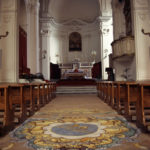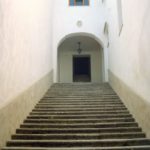Creative fidelity
See the video
>You can find the subtitles in your language next to the YouTube player controls.
Listen
Read
Mission of the Congregation –
Roots: Creative fidelity
Quite often, when I meet the people, who want to discover our roots, I see in their behavior, that they behave like the detectives. Those, who want to discover all the details about our past. There is nothing wrong with this. We should to know the past of our Congregation, we should to know the history of our Congregation, the conditions in which our Congregation was founded. But that knowledge should lead us into the awareness, that above all it is the will of God. That matters.
So in the process of discovering the roots of our Congregation, it is important that we behave like a pilgrims. We don’t want to be the searchers, the detectives, who want to discover every detail, but we want to understand, feel and almost touch, the action of the Holy Spirit, which permitted that such a Congregation was founded in the Church. It is a kind of mystical experience in which we should discover that God serves, wants to serve himself with the history of the concrete people. This mystical exploration in the times should allow us to discover those elements of our charism, which are fundamental. We could say: ‘We want to discover so called DNA of our redemptorist vocation. Somehow we should follow what pope John Paul II in the document Vita Consecrata had written: ‘We should embrace the creative fidelity’. Fidelity means to know our past, to know our roots, to have the knowledge of the people, to have the knowledge of the context in which our Congregation was born. And creativity invites us to transform those elements from the past into today, into our context.
Today our Congregation, it is like a tree, a big tree. But we should never forget, that that tree draws life from the roots. We should know our roots and know that it is through our roots, that that tree takes life, draws lives. We should always remember, that in the shade of that tree, there is our mission. Be the Church for the most abandoned, for the forgotten, for the wounded. Be the Church for those who are neglected, those who live in the peripheries, those to whom God sends us today. To take the journey into the roots of our Congregation it is to allow a very good nerves to attack us to a kind of heart beaten examination. We should examine how the heart of the redemptorist beats. If it is a good heart, if there is love in there, if there is compassion in there, if there is hope in there – if yes, we should carry on that. But if we discover, that there is something missing, we should go back to our roots, take that spiritual journey, and see clearly, what was the purpose for which our Congregation was founded and try to live it today in our times.
God, when he wants to fulfill his purpose invites human being to collaborate with him. The same happened at the beginning of our Congregation. There is a group of people that started the founding process. In that group of people we can point out four figures, which are crucial important, when we want to understand the roots, the beginnings of our Congregation. First of all we have to name Alphonsus Maria the Liguori, our founder. Secondly we can see the blessed Mary Celeste Crostarosa, the foundress of the Redemptoristines – sisters. The third figure should be bishop Tomaso Falcoia. The fourth figure, last but not least, is the blessed Gennaro Sarnelli. In my opinion, those four figures play a crucial role at the beginning of our Congregation. There is no time to analyze their lives in all details. But what we can learn from them? We can learn that at the beginning of our Congregation there is a fascinating story: divine and human.
The charism that had been given to the Church, by the working of the Holy Spirit is always fresh. Never gets old. We can change the modalities, we can change the ways in which we want to incarnate that charism, but charism as such is never old. Is never too old. The same way like it happened at the beginning of our Congregation, God invites concrete people for his mission today. We are all called to continue what started in 1732 in Scala. Our redemptorist family reminds to the humanity, in the Church, that God is rich in mercy. That his redemption is for abundant. That his redemption is for everyone. Especially for those, who are forgotten, abounded, wounded. That his redemption is directed especially to the sinners.
We all agree, that official day of the founding of our Congregation is the 9th of November 1732. The moment in which the first group of the missionaries with the bishop Falcoia had celebrated the Mass and sang the hymn to the Holy Spirit in the little town in the southern Italy in Scala. But we all have to be reminded that the founding process of the Congregation cannot be reduced only to that punctual moment. We all know that the founding process of our Congregation lasts from 1732 up to 1749 – seventeen years. In the life of St. Alphonsus we can see two periods. The first one in which we can call him the founder goes from 1732 up to 1749. Alphonsus is the founder. His reading the sings of the times, his trying to write down and experience what his congregation should be like. The second period goes from 1749 up to the year of his death. In that period we see Alphonsus as the rector maior, as the superior general. If we analyze his letters from those times we can see clearly that these two periods are present in his life. It is quite curious that during this 17 years, the first community of the redemptorists acts without any rule, any official, juridical approval. They preach missions, they go to the people, they even found our first three communities.
What’s the conclusion? The conclusion is quite clear. That for the first redemptorists what matters is life. That for the first redemptorists what matter it is our service for the most abandoned, neglected, forgotten – we can say today – wounded. Law was not of the first importants. Law will come later, after a long years of experience of practice, of being involved into missionary activity. Then we will try to write down our first rule. It is something that we can see in the way of acting of the present pope – pope Francis. He invites us to go from context into text. Not on the contrary. Know the context, know the life, experience the reality and then write it down into the law.
The first community shows quite clearly that we are the congregation of the missionaries, not of the monks. The monastic touch will come later into our history, when the Congregation spread over the Alps, especially in the territory of France. We can say somehow that our first confreres start their mission from life. They do not go into the room, they do not sit down and write first the rule. They didn’t think too much about which kind of habit we should wear. What was important it was a human being, it was mission, it was the apostolic zeal. Those years reminds us today, so we will never lose the real touch, the touch with the real reality, with the real world. They teach us that the dignity of a human being, that his identity are more important than law. They teach us finally that God is leading our mission, that he will provide. Without that knowledge, without that conviction, we will never renew our apostolic zeal again.
I like to recall one event that happened in the history of life of St. Alphonsus. After his not easy conversation with the sister Maria Celeste Crostarosa, he came back into his room in Scala, and he started to cry. He met with Cesare Sportelli (one of hist first companions) and Cesare ask him what happened. Alphonsus shared with him that it looks like God wants him to found a new missionary congregation. And Cesare would ask him: So why do you cry? And Alphonsus said: I’m worrying where I will find my first companions. I believe that we can embrace that worry of Alphonsus as an invitation for us today. We are his companions. We are his confreres. We are the followers of Jesus the Redeemer. The mission he started we continue today in the Church and in the world.
Author: Fr. Piotr Chyła
Music from https://filmmusic.io
“Sovereign” by Kevin MacLeod (https://incompetech.com)
License: CC BY (http://creativecommons.org/licenses/by/4.0/)
This post is also available in:
 polski (Polish)
polski (Polish)  Español (Spanish)
Español (Spanish)


































